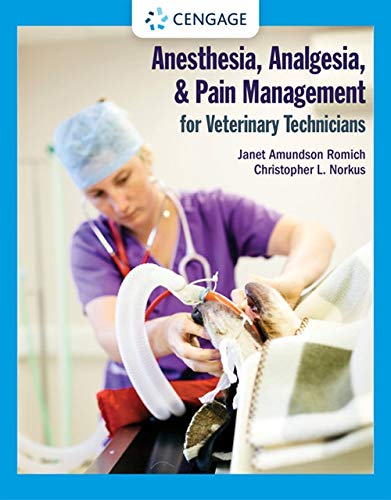Description
Solution Manual For Anesthesia Analgesia and Pain Management for Veterinary Technicians 1st Edition
All the Chapters Included
Chapter 4
Review Questions Multiple Choice Answers
- What are the types of extracellular fluids in animals?
- Intravascular, interstitial, and transcellular water
- Intracellular, synovial fluid, cerebral spinal fluid
- Urine, saliva, gastrointestinal tract secretions
- Intravascular, interstitial, and intracellular water
Answer: a
- What is true in regards to types of fluid?
a. Colloids contain microscopically dispersed suspended particles that are insoluble.
b. Crystalloids are water solutions that consist of a dissolved sodium or dextrose base with the addition of plasma proteins or clotting factors.
c. Blood products contain either whole blood or red blood cells.
d. Synthetic colloids rarely result in volume overload and are the preferred fluid for patients undergoing surgeries that last longer than 2 hours.
Answer: a
- What fluid type would be recommended for a patient in heart failure?
a. Balanced (isotonic) crystalloid solution
b. Hypertonic crystalloid solution
c. Colloid solution
d. Fluid therapy is contraindicated in patients in heart failure.
Answer: d
- Which statement regarding electrolyte composition in the body is false?
a. Sodium is the primary extracellular cation
b. Potassium is the primary intracellular cation
c. Chloride is the primary extracellular cation
d. Phosphate is the primary extracellular anion
Answer: c
- Which catheter material is less likely to initiate clot formation?
a. Polyvinyl chloride
b. Polyurethane
c. Polyethylene
d. Polypropylene
Answer: b
- Approximately how much of the original volume of a crystalloid administered IV remains in the intravascular space after one hour?
a. 25%
b. 50%
c. 75%
d. 100%
Answer: a
- What does the term gauge refer to when describing a catheter?
a. A series of whole numbers that increases from zero in increments of 0.33 mm
b. A unit used to measure catheter length and is expressed in inches
c. A descending scale in which large numbers indicate a narrower catheter diameter
d. A method of describing the degree of thrombogenicity of a catheter
Answer: c
- What criteria is catheter selection based on?
a. Patient size, type of fluid administered, and the outer diameter of the catheter
b. Expected length of time the catheter will be in place, patient’s tolerance to handling, and cost of maintaining the catheter
c. Patient size, type of fluid administered, and expected length of time the catheter will be in place
d. Skill of the veterinary technician to properly place the catheter, health status of the patient, and ability to secure the catheter in place.
Answer: c
- What is a disadvantage of over-the-needle catheters?
a. They are made from rigid materials that may kink.
b. They require long needles that may break during catheter placement.
c. They are difficult to connect to the patient and are cumbersome.
d. They require a flexible, sterile guide wire that is inserted in the lumen of the vein.
Answer: a
- Which is true regarding transfusion reactions?
a. Febrile non-hemolytic reactions are due mainly to an immune response; signs of this type of reaction include an increase in patient temperature and vomiting.
b. Actual allergic reactions produce facial swelling, hives, itchiness, and difficulty breathing which can be safely treated once the entire transfusion is given.
c. Transfusion associated circulatory overload (TACO) results in hives and edema from giving too much volume to the intravascular space.
d. Transfusion related acute lung injury (TRALI) results in jaundice from giving too much volume causing acute liver injury.
Answer: a
- Why should a wet bandage on an IV catheter be replaced?
a. It indicates that the bandage is too tight.
b. It affects fluid administration rate.
c. It changes the pH of the catheter site.
d. It wicks bacteria and can lead to infection.
Answer: d
- When putting an administration set into an infusion pump, in which position should the roller and slide clamps be in once you are ready to administer the volume to the patient?
a. Fully closed
b. Partially closed
c. Partially open
d. Fully open
Answer: d
- What are the commonly available administration sets for delivering calculated fluid rates?
a. 5, 10, 15, and 20 gtt/mL
b. 10, 20, 30, and 40 gtt/mL
c. 10, 15, 20, and 60 gtt/mL
d. 20, 40, 60, and 80 gtt/mL
Answer: c
- Which type of fluid replaces daily volume and electrolyte loss from normal body functions?
a. Ongoing maintenance
b. Replacement
c. Ongoing fluid loss
d. Resuscitation
Answer: a
- Why might plasma be administered to a patient?
a. To provide oxygen to tissues as well as plasma volume to expand the intravascular Space
b. To cause water movement into the cells and to replace free water deficits in hypernatremic patients
c. To expand the intravascular space and provide a source of albumin, clotting factors, and A source of colloidal osmotic pressure
d. To expand plasma volume and to correct hyponatremia or metabolic alkalosis
Answer: c
- Which is not a sign of fluid overload?
a. Chemosis
b. Weight gain
c. Hypoxemia
d. Bradypnea
Answer: d

Reviews
There are no reviews yet.